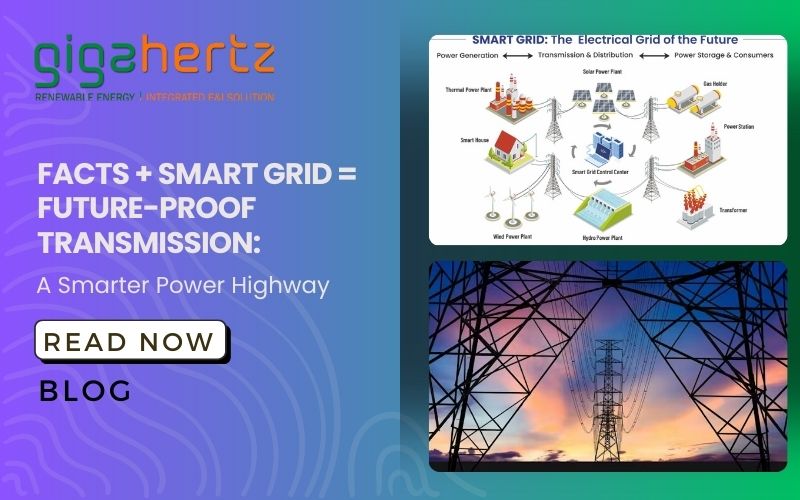
As the electricity grid evolves into a digital, distributed, and decarbonized network, the traditional model of power transmission is under increasing pressure. The rise of renewable energy, electric vehicle (EV) loads, and interconnectivity demands more than just physical infrastructure—it demands intelligence, flexibility, and resilience.
This is where Flexible AC Transmission Systems (FACTS) and Smart Grid technologies converge, forming the backbone of a future-proof transmission network.
The Smart Grid Vision
A Smart Grid is a modern, intelligent electrical grid that leverages:
-
Real-time data from sensors and smart meters
-
Advanced automation and control systems
-
Integrated communication networks
-
Machine learning and predictive analytics
Together, these enable self-healing capabilities, dynamic control, and seamless integration of renewable energy sources such as wind, solar, energy storage, and EVs.
Role of FACTS in Smart Grid
Flexible AC Transmission Systems (FACTS) are power-electronic devices that dynamically control transmission parameters like voltage, impedance, power flow, and phase angle. By doing so, they enhance grid stability, transmission efficiency, and power transfer capability, especially under fluctuating load and generation conditions.
How FACTS and Smart Grid Work Together
When combined, FACTS devices and Smart Grid systems complement each other to build a smarter, more resilient grid:
-
Voltage Stability – Devices like STATCOM and SVC regulate voltage at critical nodes, while smart sensors detect dips and swells in real time.
-
Congestion Management – TCSC and SSSC manage power flows to avoid overloads, while SCADA and EMS reroute power based on real-time data.
-
Renewable Integration – FACTS regulate reactive power and ramping, while Smart Grid systems forecast variability and manage dispatch.
-
Grid Resilience – FACTS dampen oscillations and stabilize faults, while smart systems enable auto-isolation and restoration.
-
Peak Load Management – FACTS optimize line usage, while Smart Grid platforms manage demand through Demand Response (DR) and Advanced Metering Infrastructure (AMI).
Example Use Case: Hybrid Renewable Corridor in India
A 220 kV transmission line in Rajasthan illustrates the real-world impact of FACTS + Smart Grid integration. The corridor faces:
-
Rapid voltage fluctuations due to solar and wind generation
-
Congestion during peak renewable output
-
Reactive power imbalances
Solution: Deploying a STATCOM at the pooling station ensures dynamic voltage control. Integration with SCADA/EMS enables real-time response, while PMUs and WAMS monitor oscillations and execute protection schemes. This synergy keeps the renewable corridor stable, efficient, and renewable-ready.
Benefits of Integrating FACTS into Smart Grids
-
Real-Time Grid Intelligence – FACTS provide actionable control while Smart Grid systems enable continuous monitoring.
-
Enhanced Asset Utilization – Maximize existing transmission capacity and delay costly infrastructure upgrades.
-
Better Renewable Hosting Capacity – Seamlessly integrate wind, solar, and BESS without curtailment.
-
Reduced Losses and Operational Costs – Optimize reactive power, prevent overcompensation, and minimize transmission losses.
-
Resilience Against Disturbances – Rapid response to faults, load spikes, and islanding events.
Key Technologies Involved
-
Power Electronics: Thyristors, IGBTs, VSCs
-
Communication Protocols: IEC 61850, IEC 60870-5-104, Modbus
-
Monitoring Tools: SCADA, PMU, WAMS, IoT sensors
-
Control Platforms: EMS/DMS, AI-based forecasting engines
Global Deployments
-
Germany: Uses FACTS + Smart Grid for balancing offshore wind energy.
-
India: PGCIL deploys STATCOMs integrated with SCADA in renewable corridors.
-
USA: PJM and ERCOT leverage FACTS for real-time congestion management.
Conclusion: Building a Grid That Thinks and Acts
The transmission network of the future is no longer just physical—it is cyber-physical. By integrating FACTS devices with Smart Grid technologies, utilities can:
-
Manage tomorrow’s energy challenges
-
Build renewable-ready grids
-
Enhance flexibility and reliability
-
Delay CAPEX-heavy infrastructure expansions
FACTS + Smart Grid = Resilient, Responsive, Renewable-Ready Power Systems.
Category: Smart Grid
